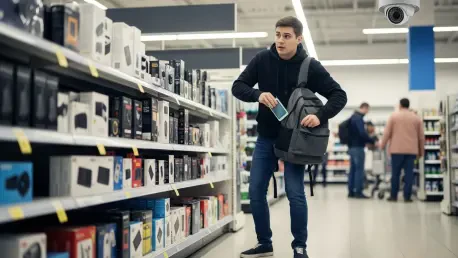In the bustling streets of New York City, a quiet but pervasive threat has been disrupting the retail sector: a sharp rise in organized retail theft that has cost businesses millions and shaken community safety. Reports indicate that post-pandemic recovery brought with it an alarming spike in such crimes, with storefronts—both large and small—facing brazen thefts and sophisticated criminal networks. This growing crisis has not only strained the financial health of retailers but also raised broader concerns about public safety and the quality of life in urban centers. What steps are being taken to curb this epidemic, and can New York reclaim its reputation as a safe hub for commerce?
Understanding the Retail Theft Crisis in New York
The retail theft crisis in New York State, particularly in New York City, emerged as a significant challenge following the COVID-19 pandemic. As businesses reopened and foot traffic returned to pre-pandemic levels, organized retail crime surged, impacting everything from major chain stores to small, family-owned shops. The financial toll has been staggering, with losses running into the millions, while the psychological impact on store employees and local communities has deepened fears about safety in everyday shopping environments.
This issue transcends mere property crime, evolving into a public safety concern that affects entire neighborhoods. Key areas like Manhattan and Brooklyn have reported the highest incidents, drawing attention from major players such as retailers, law enforcement agencies, and policymakers at both local and state levels. The societal significance cannot be understated, as unchecked retail theft contributes to a perception of lawlessness, deterring customers and threatening the economic vitality of commercial districts.
Governor Hochul’s Comprehensive Response to Retail Theft
Key Initiatives and Funding Allocations
To combat this escalating problem, Governor Kathy Hochul has rolled out an ambitious plan backed by substantial resources. A cornerstone of this strategy is a $40.2 million investment to establish dedicated Retail Theft Teams, comprising State Police, District Attorneys’ offices, and local law enforcement units. Additionally, 100 extra State Police personnel have been deployed to focus specifically on dismantling organized retail crime networks, with notable successes including a major 2024 operation that busted an international theft ring and recovered over $2 million in stolen goods.
Beyond enforcement, support for vulnerable small businesses forms a critical pillar of the response. A $5 million security enhancement fund has been allocated to help these retailers fortify their premises, complemented by a $3,000 tax credit for those investing in theft prevention measures. These financial aids aim to level the playing field, ensuring that smaller players, often hardest hit by theft, can protect their livelihoods without breaking the bank.
Legislative Reforms and Enforcement Strategies
On the legislative front, new laws have been enacted to strengthen the state’s stance against retail crime. One significant reform elevates the assault of retail workers to felony status, reflecting a commitment to protecting frontline employees who often bear the brunt of violent encounters during thefts. Another measure allows prosecutors to aggregate the value of stolen goods across multiple incidents, facilitating harsher charges under a unified criminal scheme.
Further tightening the net, legislation now targets third-party sellers, making it illegal to facilitate the sale of stolen goods through online platforms or physical outlets. This disrupts the downstream market for illicit items, while enhanced collaboration between law enforcement, prosecutors, and community organizations ensures a coordinated approach. Such partnerships are vital for addressing the complex, multi-layered nature of organized retail crime in a densely populated state like New York.
Challenges in Combating Retail Theft
Despite these robust measures, eradicating organized retail theft remains an uphill battle due to the sophistication of criminal networks. These groups often operate across state lines and employ advanced tactics, making them difficult to track and apprehend. Resource constraints also pose a hurdle, particularly for small businesses that struggle to afford comprehensive security systems even with state support, leaving them vulnerable to repeated incidents.
The rise of online platforms as conduits for selling stolen goods adds another layer of complexity, as digital transactions can obscure the origins of merchandise. Addressing this requires innovative technological solutions, such as advanced tracking systems for stolen items, alongside stronger partnerships between retailers and law enforcement to share intelligence and preempt criminal activities. Overcoming these obstacles demands adaptability and sustained investment in both human and digital resources.
Impact of Policies and Public Safety Outcomes
The tangible impact of Governor Hochul’s initiatives is evident in recent crime statistics, showcasing a promising downward trend. Retail theft in New York City has dropped by over 12%, translating to nearly 5,000 fewer incidents compared to previous peaks, while the state as a whole has seen a 5% reduction. These figures mark a return to pre-surge levels, offering a glimmer of hope to retailers who have endured years of uncertainty and loss.
Broader public safety improvements further underscore the effectiveness of these policies, with New York City reporting a 4% decline in overall index crime, an 11% drop in felony robberies, and significant reductions in shootings and murders. Supported by nearly $3 billion in public safety investments, these outcomes reflect a holistic approach that not only targets retail theft but also enhances community well-being, addressing quality-of-life issues that affect both businesses and residents on a daily basis.
Future Outlook for Retail Security in New York
Looking ahead, sustaining these gains will require long-term strategies that leverage emerging technologies for theft prevention, such as AI-driven surveillance and blockchain-based tracking of goods. Retail security must evolve in tandem with consumer expectations, which increasingly prioritize safe shopping environments as a non-negotiable aspect of their experience. Continued collaboration among stakeholders—retailers, law enforcement, and policymakers—will be essential to stay ahead of evolving criminal tactics.
Economic conditions and regulatory adjustments will also play a pivotal role in shaping a safer retail landscape. Proactive measures, such as incentivizing innovation in security solutions and fostering public-private partnerships, can help build resilience against future surges in crime. By focusing on prevention rather than reaction, New York can position itself as a leader in retail security, balancing economic growth with community safety over the coming years.
Conclusion: Progress and the Path Forward
Reflecting on the strides made under Governor Hochul’s leadership, it is clear that a multi-pronged approach combining enforcement, legislative reform, and business support has yielded significant progress in curbing retail theft across New York. The measurable declines in crime rates and the bolstered sense of safety among communities and retailers stand as testaments to the effectiveness of these efforts. Each initiative, from funding Retail Theft Teams to protecting small businesses, contributes to a safer commercial environment.
Moving forward, the focus should shift toward integrating cutting-edge technologies and deepening inter-agency collaborations to anticipate and prevent crime before it occurs. Stakeholders must also explore scalable solutions that empower smaller retailers with affordable security options, ensuring no business is left behind. By maintaining this momentum and adapting to new challenges, New York can solidify its standing as a beacon of safety and economic opportunity for all who operate within its borders.








